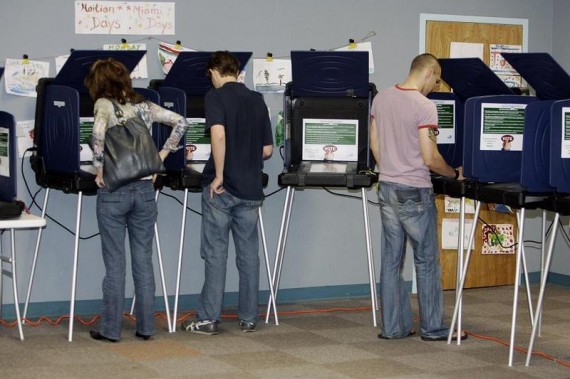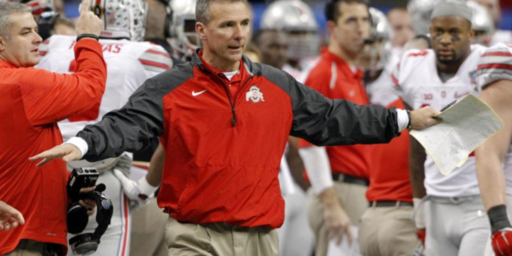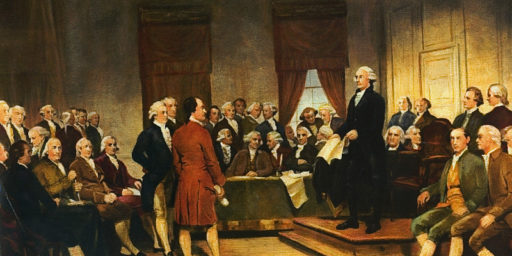Supreme Court Hears Argument On Ohio’s Voter Purge Law
The Supreme Court heard argument yesterday in an important case dealing with the circumstances under which voters can be purged from the voting rolls.
Yesterday, the Supreme Court heard oral argument in a case out of Ohio regarding that state’s policy of periodically purging voter rolls of people who have not voted in recent elections:
WASHINGTON — In a spirited argument on Wednesday, the Supreme Court appeared deeply divided over whether Ohio may kick people off the voting rolls if they skip a few elections and fail to respond to a notice from state officials.
Justice Sonia Sotomayor said Ohio’s approach effectively disenfranchised minority and homeless voters in the state’s major cities and was part of a broader effort to suppress voting.
“All of these impediments result in large numbers of people not voting in certain parts of the state,” she said.
But Justices Anthony M. Kennedy and Stephen G. Breyer expressed concern about maintaining the integrity of the state’s list of eligible voters.
“The reason they’re purging them,” Justice Kennedy said, “is they want to protect the voter rolls from people that have moved.”
Justice Breyer fleshed out the point. “Every year a certain number of people die, and every year a certain number move to California,” he said. “We don’t want them on the voter roll. That used to be a big problem, voting dead people.”
The case concerns Larry Harmon, a software engineer and Navy veteran who lives near Akron, Ohio. He voted in the 2004 and 2008 presidential elections but skipped the next one, saying he was unimpressed by the candidates. He also sat out the midterm elections in 2010 and 2014.
In 2015, Mr. Harmon did want to vote, against a ballot initiative to legalize marijuana. But his name had been stricken from the voting rolls.
Federal laws prohibit states from removing people from voter rolls “by reason of the person’s failure to vote.” But they allow election officials who suspect that a voter has moved to send a confirmation notice.
A central question in the case was whether a failure to vote could be the reason to send out the notice.
Ohio is more aggressive than any other state in purging its voter rolls. After skipping a single federal election cycle, voters are sent a notice. If they fail to respond and do not vote in the next four years, their names are purged from the rolls.
A few other states use similar approaches, but not one of them moves as fast. “Ohio is the only state that commences such a process based on the failure to vote in a single federal election cycle,” said a brief from the League of Women Voters and the Brennan Center for Justice. “Literally every other state uses a different, and more voter-protective, practice.”
At Wednesday’s argument, Eric E. Murphy, Ohio’s state solicitor, said about eight states send out notices based on the failure to vote.
Justice Ruth Bader Ginsburg said there was good reason to think that “Congress didn’t want failure to vote to be a trigger for this procedure.”
But Justice Samuel A. Alito Jr. said the laws appeared to permit Ohio to use its notification process.
“Why isn’t the best interpretation of this that one cannot be removed from the list solely because of failure to vote?” he asked. The failure to respond to the notice, he suggested, was an additional reason.
Paul M. Smith, a lawyer for the challengers, said there were far more reliable methods of figuring out whether people had moved, including consulting records kept by the post office and motor vehicle departments.
On the other hand, Mr. Smith said, “the failure to vote for two years tells you almost nothing about whether or not anybody has moved.”
He said more than half of Ohio voters sit out elections over a two-year period and 70 percent of people who receive notices from the state do not return them.
“The process is vastly overbroad in its design,” Mr. Smith said. “You’re just going to end up with a lot of false positives.”
Mr. Smith added that it is lawful for states to send nonforwardable notices based on the failure to vote, and take action based on the ones returned as undeliverable.
Chief Justice John G. Roberts Jr. seemed surprised by the concession. “So the triggering event can be the failure to vote?” he asked. “I would have thought that’s inconsistent with the rest of your argument.”
But the distinction between a failure to respond to a notice and one returned as undeliverable seemed to appeal to Justice Breyer.
(…)
A Reuters study in 2016 found that at least 144,000 people were removed from the voting rolls in recent years in Ohio’s three largest counties, which are home to Cleveland, Cincinnati and Columbus.
“Voters have been struck from the rolls in Democratic-leaning neighborhoods at roughly twice the rate as in Republican neighborhoods,” the study found. “Neighborhoods that have a high proportion of poor, African-American residents are hit the hardest.”
Twelve states, generally led by Democrats, filed a brief supporting Mr. Harmon. Seventeen states, generally Republican, filed a brief on the other side.
The Justice Department for decades took the position that failing to vote should not lead to disenfranchisement. In the appeals court, the Obama administration filed a brief supporting Mr. Harmon.
After the last presidential election, the department switched sides in the case, Husted v. A. Philip Randolph Institute, No. 16-980
Amy Howe analyzes the argument for SCOTUSBlog:
The Supreme Court heard oral argument today in a challenge to a practice that Ohio uses to maintain its voter-registration lists. Under Ohio law, a voter who does not vote for two years is sent a notice, which asks him to confirm that he is still eligible to vote. If the voter does not return the notice and does not vote for the next four years, he is removed from the voter lists. The challengers argue that this practice violates federal law, which bars states from removing voters from their lists based on a failure to vote. Ohio counters that voters aren’t removed because they don’t vote; the removal only happens if they fail to respond to the notice that is mailed to them and then abstain from voting for four more years. Today the court’s more conservative justices seemed inclined to agree with the state – and could even pick up a sixth vote, from Justice Stephen Breyer.
Arguing on behalf of Ohio, state solicitor general Eric Murphy faced tough questions from some of the court’s more liberal justices. Justice Sonia Sotomayor focused on what she described as the “essence of this case.” Your position, she told Murphy, is that a failure to vote is enough evidence to suggest that someone has moved. But is that a reasonable conclusion to draw, she asked, when it has a disproportionate effect on areas with large groups of minorities, poor people and the homeless? These groups, she noted, tend to vote at lower rates than the rest of the population, “in large measure because many of them work long hours.” “How can we read this statute,” Sotomayor continued, “to permit you to begin a process of disenfranchising solely on the basis” of someone’s failure to vote, with no evidence that the voter has actually moved? “There are dozens of other ways” for the state to determine whether someone has moved, Sotomayor emphasized, ranging from the U.S. Postal Service to juror and driver changes of address. And I have to give the provision barring removal based on a failure to vote a meaning that avoids disenfranchising people, she concluded.
(…)
The topic of whether and how states can gather reliable evidence that someone has moved occupied much of the 30-plus minutes of oral argument for Paul Smith, who represented the challengers. Smith repeatedly told the justices that a voter’s failure to show up at the polls “simply does not provide adequate evidence that the person has moved at all.”
But Alito pushed back. In Ohio, he told Smith, failure to vote is not, standing alone, a ground for being removed from the voter lists. Instead, he posited, it is just evidence that someone may have moved out of the district.
In what could be an ominous sign for the challengers, Breyer seemed frustrated that states were left with what he seemed to regard as an impossible task. How, he asked Smith, are states supposed to track people who die or move out of state, to figure out whether they need to be removed from voter-registration lists? “We don’t want them on the voter roll,” Breyer declared. “That used to be a big problem, voting dead people.” He picked up this line of questioning again later on, telling Smith that he didn’t “believe Congress would have passed a statute that would prevent a state from purging a voting roll of people who have died or have moved out of the state.”
Kennedy repeated this sentiment, telling Smith that states were purging registration lists “to protect the voter rolls from people” who have moved and are “voting in the wrong district.”
Breyer later asked Smith whether a state could send out a card, labeled with instructions not to forward, to voters. If someone has moved, Breyer suggested, “and they wait long enough, and they send it a couple of times, the post office will send it back and then they’ll know the person has moved.”
Kevin Drum, meanwhile, notes that Ohio’s laws appear to comply with the relevant Federal laws:
I took a look at the text of the 1993 motor voter law. Here’s the relevant section:
Any State program or activity to protect the integrity of the electoral process by ensuring the maintenance of an accurate and current voter registration roll for elections for Federal office…shall not result in the removal of the name of any person from the official list of voters registered to vote in an election for Federal office by reason of the person’s failure to vote, except that nothing in this paragraph may be construed to prohibit a State from using the procedures described in subsections (c) and (d) of this section to remove an individual from the official list of eligible voters if the individual - (A) has not either notified the applicable registrar (in person or in writing) or responded during the period described in subparagraph (B) to the notice sent by the applicable registrar; and then (B) has not voted or appeared to vote in 2 or more consecutive general elections for Federal office.
Section (c) is about purging voter rolls based on change-of-address information from the Post Office. Here is section (d):
A State shall not remove the name of a registrant from the official list of eligible voters in elections for Federal office on the ground that the registrant has changed residence unless the registrant…has failed to respond to a notice…and has not voted or appeared to vote…in an election during the period beginning on the date of the notice and ending on the day after the date of the second general election for Federal office that occurs after the date of the notice.
The Ohio program follows this to the letter: they send a notice, and then purge you from the voting rolls if you fail to vote over the next four years—which is two federal elections. The only remaining question, then, is the same one we started with: Does the precipitating event have to be evidence of a change of residence, or can it be failure to vote?
Section (c) of the law is all about using change-of-address information as a reason to start the removal process, and the fact that there’s a separate Section (d) implies that there can be other reasons too. The question, then, is whether failure to vote for two years can be one of them. As near as I can tell, the motor voter law is silent about that.
After learning that his name had been purged from the voter rolls, Harmon brought suit against the State Of Ohio alleging that the manner in which the state enforced its voter purge policies violated the National Voter Registration Act of 1993, popularly known as the “Motor Voter Act” due to the fact that it forced states to tie voter registration into the process of applying for a driver’s license in an effort to make it easier for voters to register to vote. In addition to those provisions, though, the law also contains provisions setting forth limitations on the state’s ability to purge its voter rolls in order to ensure that citizens are not deprived of their right to vote. This includes provisions governing the circumstances under which states can act to purge their voter rolls. Initially, the District Court ruled in favor of the State Ohio, ruling that Harmon had failed to establish the facts necessary to show that Ohio’s law in general, or the manner in which it was applied against him specifically, violated the relevant statute. That ruling was overturned by the Sixth Circuit Court of Appeals in a ruling by a panel consisting of Judges appointed by Presidents George H.W. Bush, Clinton, and George W. Bush. In that ruling, the Sixth Circuit found that Ohio’s procedures violated the 1993 law and that Harmon’s removal from the rolls pursuant to those procedures was therefore invalid. The state then sought review by the Supreme Court, which was granted at the end of the last term.
As a matter of both law and policy, it strikes me that the State of Ohio has the better argument here and that states ought to be given the benefit of the doubt when policing their voter rolls unless there is evidence that the policy in question is being applied in some discriminatory fashion, an argument that is not being raised in this case. Keeping inactive voters, or voters who have moved out of state or died, on the rolls increases the likelihood that someone could vote illegally in their place as we If someone fails to vote in several elections and also fails to respond to non-forwardable correspondence sent to their last known address warning them that they are in danger of being purged from the voting rolls if they don’t at least respond to the notice by acknowledging receipt of the notice, then it seems to me that it is safe for the state to assume that the voter has either moved, died, or simply isn’t interested in remaining registered to vote for one reason or another. Additionally, as Kevin Drum notes in the piece quoted above, it seems clear that, contrary to the Sixth Circuit’s ruling, Ohio’s procedures do in fact comply with the letter of the relevant Federal law. One could argue that the failure to vote for two successive years is not a sufficient amount of time to judge that someone is an “inactive voter,” but as Drum notes the relevant law is silent about how long a state must wait before acting to purge its rolls. Given that, I would suspect that the Court will ultimately rule in favor of Ohio in this case, especially given the fact that oral argument appears to show a solid majority of the Justices inclined to rule in favor of the law rather than for Harmon.
Here’s the transcript of yesterday’s argument:
Husted v. A. Philip Randolph Institute Et Al by Doug Mataconis on Scribd







1) Glad to read that the case has standing, so there’s that.
2) Having been Ohio-adjacent, people who move, transition and skip elections are not the god-fearing folk in the heartland of Ohio. Get away from some of the urban areas, and it’s serious Jesus-land, and the heart of Dixie. If they want to maintain that GOP red, they the MUST purge those polls and quick… why can the Supreme court understand that… easy-peasy.
3) Having dead folks on the rolls… won’t create enough of a swing even if all the dead folks currently on the rolls in a state were to rise and vote. Voter fraud is just the GOP boogyman dog-whistle for keeping some folks in their place (or in this case, displaced).
4) Finally: Ohio, uuugh. I would take Nebraska over Ohio, if it wasn’t for the persistent cattle-urine smell once you are past Omaha.
@Liberal Capitalist:
The standing issue wasn’t really a major part of the oral argument, but that doesn’t mean that it could not be an issue in the final opinion.
That being said, given the fact that the main Plaintiff in this case was actually purged from the rolls it seems pretty clear that he has standing.
It seems odd electoral officials would rely solely on the post to notify voters. What is this, the XIX Century? Given they must have a name and address, otherwise how they can even send a notice to begin with, they should be able to obtain a cell phone number, home number, and email. Personal data is sold and traded all over the place, too. Surely state election officials can use that market to locate their wayward voters.
@Kathy:
Only if they want to.
I do not see in the post, without following links, what happened to Mr. Harmon at the polling place. Was he allowed a provisional ballot, which was subsequently counted after verifying residence, which he had presumably just done, as in OH I have to show ID, usually a drivers license. If they counted a provisional ballot from Harmon it would seem to be a no harm, no foul situation. But it sounds like he was denied his right to vote.Remember that Ohio is the home of Ken Blackwell. We aren’t up to southern state standards, but we do have a history of vote suppression.
Completely off topic, but what happened in the Bundy case? IANAL but I would love to see your take, Doug. Was the case dismissed because of complete ineptitude on the part of the prosecutors or was there perhaps sabotage by state or federal officials?
When I started voting in local elections in the early 1980’s I didn’t pay much attention to Dem vs. Repub. In fact, although I vaguely remember a few city councilmen and stat reps from that era, I can’t remember what party they belonged to. Fast forward to today, when I literally would not vote for a Republican as dog catcher. I consider the entire party so toxic that any support at any level hurts the country as a whole.
It’s been fascinating (in a “let’s watch how this ulcer festers” kind of a way) to see the transformation of a party from one that had politicians like Nelson Rockefeller or Jon Anderson to one in which Republican Congressional leaders speak in support of child molesters and deviants, and Committee Chairmen use their powers to attack the FBI and Justice Department for investigating collusion with our national enemies and obstruction of justice. This Ohio law shows where the Party of Lies and Racism is at today, whether it be upheld or struck down. The Republicans have completely given up on reaching out to more voters. Instead their entire strategy is to prevent as many non-white, non-old, non-wealthy people from voting as they can. Even three years ago you would hear senior people in the party talk about the need to reach out* to Hispanics or Asians or women (but never Blacks) in order to avoid demographic doom. Unfortunately, those who spoke out were rewarded with electoral defeats and are now gone.
*It’s worth noting what these people considered “reaching out”. In watching and reading hundreds of instances of these Big Tent Repubs explaining their outreach strategy, it was always about how they just needed a chance to explain to Hispanics/Asians/Women how great Repub policies were and how excited they should be to support them. In other words, their outreach was 100% in one direction, consisting of explaining to people why their were wrong and/or ignorant. At some point I started keeping track and in at least a couple of years I didn’t hear one single Republican leader suggest that maybe “outreach” should have an element of sitting down with these groups and listening to what they had to say, and understanding what they were concerned about. “Outreach” was “We will let you in the Old White Guy club so you can vote how we tell you too, but don’t become bothersome by expecting to have any influence here.”
@gVOR08:
I’ve not heard any account as to whether he was offered a provisional ballot.
Consulting the SoS (Ohio) website regarding provisional ballots is inconclusive on the question of provisional ballots for persons not registered to vote (as would be the case of someone whose name has been removed from the voting registry).
Entertains a more generalized question: How does a provisional voter know if his ballot has been counted?
@gVOR08: IANAL either, but living across the river from Oregon and following the case on the news, my take is the charge was idiotic–I hold actual and real bias against the Bundys and would like to see Clevin and his kids, friends, known associates, etc. rot in jail and I wouldn’t have convicted them of that charge. Still, and article with Doug’s take on the trial–or the one in Las Vegas (I just realized there were two) would be interesting.
I think the Bundys deserved to rot in jail. But there is way too much prosecutorial misconduct in this country and they get away with it way too often, and it’s simply unacceptable. You can’t vote to convict when there is misbehavior like that shit.
@Teve tory: From what I’ve read about the Bundy case, the prosecutorial misconduct was mainly focused around governmental misconduct which happened throughout the incident, and the dismissal with prejudice was of a kin to the dismissal of the charges against William “guilty as sin, free as a bird” Ayers.
I have a theory as to why the dismissal will get minimal to no attention here — certainly nowhere near the coverage the initial incident got — but I think I’ll keep my own counsel on that… for now.
@Bob The Arqubusier: I forgot a few key words above — my apologies.